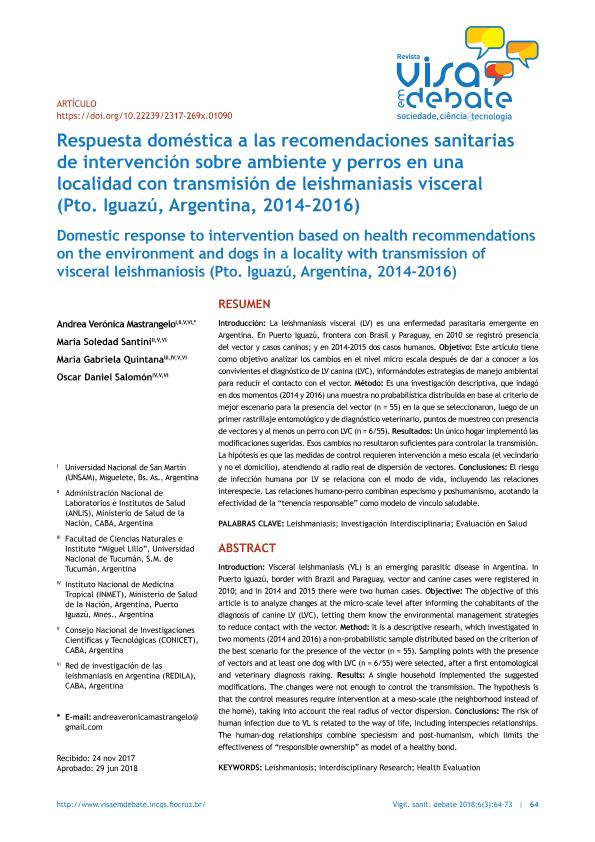Mostrar el registro sencillo del ítem
dc.contributor.author
Mastrangelo, Ana Verónica
dc.contributor.author
Santini, Maria Soledad

dc.contributor.author
Quintana, María Gabriela

dc.contributor.author
Salomón, Oscar Daniel

dc.date.available
2019-08-09T13:59:32Z
dc.date.issued
2018-08
dc.identifier.citation
Mastrangelo, Ana Verónica; Santini, Maria Soledad; Quintana, María Gabriela; Salomón, Oscar Daniel; Respuesta doméstica a las recomendaciones sanitarias de intervención sobre ambiente y perros en una localidad con transmisión de leishmaniasis visceral (Pto. Iguazú, Argentina, 2014–2016); Fundação Oswaldo Cruz; Vigilância Sanitária em Debate; 6; 3; 8-2018; 64-73
dc.identifier.issn
2317-269X
dc.identifier.uri
http://hdl.handle.net/11336/81302
dc.description.abstract
La leishmaniasis visceral (LV) es una enfermedad parasitaria emergente enArgentina. En Puerto Iguazú, frontera con Brasil y Paraguay, en 2010 se registró presencia del vector y casos caninos; y en 2014-2015 dos casos humanos. Objetivo: Este artículo tiene como objetivo analizar los cambios en el nivel micro escala después de dar a conocer a los convivientes el diagnóstico de LV canina (LVC), informándoles estrategias de manejo ambiental para reducir el contacto con el vector. Método: Es una investigación descriptiva, que indagó en dos momentos (2014 y 2016) una muestra no probabilística distribuida en base al criterio de mejor escenario para la presencia del vector (n = 55) en la que se seleccionaron, luego de un primer rastrillaje entomológico y de diagnóstico veterinario, puntos de muestreo con presencia de vectores y al menos un perro con LVC (n = 6/55). Resultados: Un único hogar implementó las modificaciones sugeridas. Esos cambios no resultaron suficientes para controlar la transmisión.La hipótesis es que las medidas de control requieren intervención a meso escala (el vecindario y no el domicilio), atendiendo al radio real de dispersión de vectores. Conclusiones: El riesgo de infección humana por LV se relaciona con el modo de vida, incluyendo las relaciones interespecie. Las relaciones humano-perro combinan especismo y poshumanismo, acotando la efectividad de la tenencia responsable como modelo de vínculo saludable.
dc.description.abstract
Introduction: Visceral leishmaniasis (VL) is an emerging parasitic disease in Argentina. In Puerto Iguazú, border with Brazil and Paraguay, vector and canine cases were registered in 2010; and in 2014 and 2015 there were two human cases. Objective: The objective of this article is to analyze changes at the micro-scale level after informing the cohabitants of the diagnosis of canine LV (LVC), letting them know the environmental management strategies to reduce contact with the vector. Method: It is a descriptive researh, which investigated in two moments (2014 and 2016) a non-probabilistic sample distributed based on the criterion of the best scenario for the presence of the vector (n = 55). Sampling points with the presence of vectors and at least one dog with LVC (n = 6/55) were selected, after a first entomological and veterinary diagnosis raking. Results: A single household implemented the suggested modifications. The changes were not enough to control the transmission. The hypothesis is that the control measures require intervention at a meso-scale (the neighborhood instead of the home), taking into account the real radius of vector dispersion. Conclusions: The risk of human infection due to VL is related to the way of life, including interspecies relationships. The human-dog relationships combine speciesism and post-humanism, which limits the effectiveness of “responsible ownership” as model of a healthy bond.
dc.format
application/pdf
dc.language.iso
spa
dc.publisher
Fundação Oswaldo Cruz

dc.rights
info:eu-repo/semantics/openAccess
dc.rights.uri
https://creativecommons.org/licenses/by-nc-sa/2.5/ar/
dc.subject
Leishmanisis
dc.subject
Investigacion Interdisciplinaria
dc.subject
Evaluacion en Salud
dc.subject.classification
Salud Ocupacional

dc.subject.classification
Ciencias de la Salud

dc.subject.classification
CIENCIAS MÉDICAS Y DE LA SALUD

dc.title
Respuesta doméstica a las recomendaciones sanitarias de intervención sobre ambiente y perros en una localidad con transmisión de leishmaniasis visceral (Pto. Iguazú, Argentina, 2014–2016)
dc.title
Domestic response to intervention based on health recommendations on the environment and dogs in a locality with transmission of visceral leishmaniosis (Pto. Iguazú, Argentina, 2014-2016)
dc.type
info:eu-repo/semantics/article
dc.type
info:ar-repo/semantics/artículo
dc.type
info:eu-repo/semantics/publishedVersion
dc.date.updated
2019-08-06T18:15:34Z
dc.journal.volume
6
dc.journal.number
3
dc.journal.pagination
64-73
dc.journal.pais
Brasil

dc.journal.ciudad
Sao Paulo
dc.description.fil
Fil: Mastrangelo, Ana Verónica. Dirección Nacional de Institutos de Investigación. Administración Nacional de Laboratorios e Institutos de Salud. Centro Nacional de Diagnóstico e Investigaciones Endemo-epidémicas; Argentina. Universidad Nacional de San Martín; Argentina. Consejo Nacional de Investigaciones Científicas y Técnicas; Argentina
dc.description.fil
Fil: Santini, Maria Soledad. Dirección Nacional de Institutos de Investigación. Administración Nacional de Laboratorios e Institutos de Salud. Centro Nacional de Diagnóstico e Investigaciones Endemo-epidémicas; Argentina. Consejo Nacional de Investigaciones Científicas y Técnicas; Argentina
dc.description.fil
Fil: Quintana, María Gabriela. Universidad Nacional de Tucumán. Facultad de Ciencias Naturales e Instituto Miguel Lillo; Argentina. Ministerio de Salud. Instituto Nacional de Medicina Tropical; Argentina. Consejo Nacional de Investigaciones Científicas y Técnicas; Argentina
dc.description.fil
Fil: Salomón, Oscar Daniel. Ministerio de Salud. Instituto Nacional de Medicina Tropical; Argentina. Consejo Nacional de Investigaciones Científicas y Técnicas; Argentina
dc.journal.title
Vigilância Sanitária em Debate
dc.relation.alternativeid
info:eu-repo/semantics/altIdentifier/doi/https://doi.org/10.22239/2317-269x.01090
dc.relation.alternativeid
info:eu-repo/semantics/altIdentifier/url/https://visaemdebate.incqs.fiocruz.br/index.php/visaemdebate/article/view/1090/495
Archivos asociados
